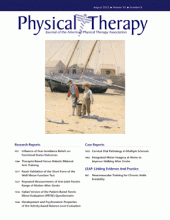Abstract
Background The influence of elevated fear-avoidance beliefs on change in functional status is unclear.
Objective The purpose of this study was to determine the influence of fear-avoidance on recovery of functional status during rehabilitation for people with shoulder impairments.
Design A retrospective longitudinal cohort study was conducted.
Methods Data were collected from 3,362 people with musculoskeletal conditions of the shoulder receiving rehabilitation. At intake and discharge, upper-extremity function was measured using the shoulder Computerized Adaptive Test. Pain intensity was measured using an 11-point numerical rating scale. Completion rate at discharge was 57% for function and 47% for pain intensity. A single-item screen was used to classify patients into groups with low versus elevated fear-avoidance beliefs at intake. A general linear model (GLM) was used to describe how change in function is affected by fear avoidance in 8 disease categories. This study also accounted for within-clinic correlation and controlled for other important predictors of functional change in functional status, including various demographic and health-related variables. The parameters of the GLM and their standard errors were estimated with the weighted generalized estimating equations method.
Results Functional change was predicted by the interaction between fear and disease categories. On further examination of 8 disease categories using GLM adjusted for other confounders, improvement in function was greater for the low fear group than for the elevated fear group among people with muscle, tendon, and soft tissue disorders (Δ=1.37, P<.01) and those with osteopathies, chondropathies, and acquired musculoskeletal deformities (Δ=5.52, P<.02). These differences were below the minimal detectable change.
Limitations Information was not available on whether therapists used information on level of fear to implement treatment plans.
Conclusions The influence of fear-avoidance beliefs on change in functional status varies among specific shoulder impairments.
Footnotes
Dr Sindhu, Dr Lehman, and Dr Tarima provided concept/idea/research design. Dr Sindhu, Dr Lehman, Dr Bishop, and Mr Klein provided writing. Dr Hart provided data collection and participants. Dr Sindhu, Dr Lehman, Dr Tarima, Dr Bishop, Mr Klein, Mr Shivakoti, and Dr Wang provided data analysis. Dr Tarima, Dr Hart, and Mr Shivakoti provided consultation (including review of manuscript before submission). The authors thank Focus On Therapeutic Outcomes, Inc (Knoxville, Tennessee) for providing data for this research project.
At the time of this study, Dr Wang and Dr Hart were employees of Focus On Therapeutic Outcomes, Inc (Knoxville, Tennessee).
This study was reviewed and approved by the institutional review boards for the protection of human subjects at the University of Wisconsin–Milwaukee and FOTO, Inc.
This work was supported, in part, by the Office of Undergraduate Research, University of Wisconsin–Milwaukee, and the Clinical and Translational Science Institute of Southeast Wisconsin, Medical College of Wisconsin.
- Received September 17, 2011.
- Accepted May 21, 2012.












